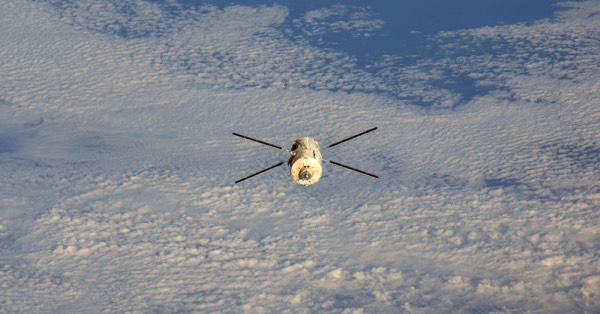15 years ago, on March 9, 2008, the first Ariane 5 specially adapted for very heavy payloads flawlessly launched the first European Automated Transfer Vehicle space cargo vehicle. On that day, the first European cargo freighter, named Jules Verne, set off on its incredible three-week journey to the International Space Station.
Emotions were running high for the Ariane and ATV teams: this launch marked the culmination of more than 12 years of dedication, endeavor, doubts, and hard work, on all fronts.
Over those 12 years, everything had to be created from scratch – admittedly drawing on acquired experience – by learning, inventing, designing, building, testing, making mistakes, checking, starting afresh. Then producing, assembling, preparing, practicing, and checking, over and over again.
And on March 9, 2008, it all came together. A specially adapted Ariane 5, called ES ATV, was standing on its launch pad. On board, housed in its huge fairing, was the ATV, an enormous cylindrical freighter, as big as a London double-decker bus – 10 meters long and 4.5 meters in diameter. It weighed nearly 20 tons, more than twice the largest payload ever carried before on an Ariane 5. It was Europe’s first orbital service vehicle, supplying water, oxygen, fuel, food, clothing, and scientific equipment for the ISS crew. On the ground, the European, Russian, and American launch and flight operations control teams were tense, absolutely focused on the lift-off.

Photos ESA – CNES – ARIANESPACE / Photo Activité Optique Vidéo CSG
Designed and built for the European Space Agency (ESA) by the company that was later to become ArianeGroup, the ATV space freighter was the largest and most complex spacecraft ever developed and produced in Europe. It was a true technological masterpiece, the first European spacecraft to execute an autonomous rendez-vous with an orbiting station – flying at a speed of 28,000 km/h and with docking with a precision of just a few centimeters.
Launching this 20-ton vehicle required the development of a dedicated Ariane 5 variant, the ES ATV. Specifically designed for this mission, it was equipped with a reignitable storable propellant upper stage (EPS) powered by an Aestus engine, a reinforced vehicle equipment bay (VEB) and a redeveloped flight program.
At the precise moment when the orbital plane of the ISS was directly over the launch pad in Kourou, Ariane 5 VA181 lifted off and gently carried its precious passenger to low Earth orbit (LEO), after a perfectly executed one-and-a-half-hour sequence, involving two re-ignitions of the upper stage.
Shortly after reaching orbit, circling the Earth every 90 minutes, under the control of the flight operations control center in Toulouse in France, the ATV deployed its solar panels and its antenna, and then set out on its journey to the ISS.
It docked on 3 April, after a series of breathtaking approach maneuvers. Under the watchful eyes of the Russian and American ISS partners, the ATV carried out its mission for the following six months, racking up a number of European and world firsts, but that is another story…
March 9, 2008 will remain forever etched in the memories of the Ariane and ATV teams. A day when the dream became reality, when a new version of Ariane 5 made its inaugural flight, when the first European spacecraft made an ISS service flight, and of course the satisfaction of a job well done.
And that March 9 will also never be forgotten because it paved the way for another four ATV missions, all exemplary, between 2011 and 2015, for the launches of 12 Galileo satellites by Ariane 5 ES between 2016 and 2018, and for Europe’s participation in NASA’s Artemis program.
It should be remembered that NASA’s Orion spacecraft, which perfectly accomplished its first mission (Artemis I) at the end of 2022, is powered and equipped by the European Service Module (ESM) which is directly derived from the ATV. The ESM is the first time that the US space agency has used a non-American-built system to provide the propulsion for a spacecraft designed to carry a human crew – proof of NASA’s confidence in the excellence of the technologies and the technical expertise demonstrated by the European ATV.
Jean-Jacques Dordain, Director General of the ESA at the time, often said: “It was the ATV, with and thanks to Ariane of course, which directly enabled Europe to become recognized by the big guns in space, Russia and America, as an equal member of the club.”






































